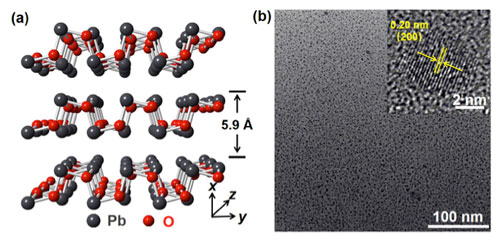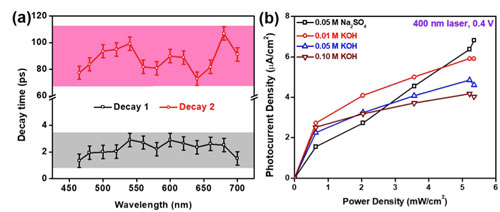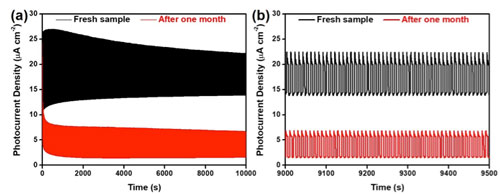Nov 06, 2018
(Nanowerk Spotlight) In recent years, black-phosphorus-analogue (BPA) two-dimensional (2D) materials have been demonstrated to exhibit promising optoelectronic performances and distinguished ambient stabilities, holding great promise in practical applications. The previous Nanowerk Spotlights on the significantly improved environmental stability of BPA-based devices for large-scale applications has already been discussed ("Black phosphorus analogues: Emerging photoelectric materials" and "The rise of phosphorene analogue optoelectronic materials").
In new research, led by Professor Han Zhang at Shenzhen University in China, and published in Nanoscale ("Two-dimensional beta-lead oxide quantum dots"), researchers demonstrated that ultra-small 2D beta-lead oxide (β-PbO) quantum dots (QDs) showed fast carrier dynamics and significantly high photocurrent density and excellent ambient stability. These findings hold great potential for high-performance BPA-based optoelectronic devices.
An orthorhombic phase of yellow-colored β-PbO (Fig. 1a), space group D11 2h, shares an identical zig-zag crystal structure with black phosphorus (BP), yet features a high stability in air, almost absolute insolubility in water and visible light sensitivity. The intriguing bandgap of PbO holds great promises in bridging the bandgap space between transition-metal dichalcogenides (1 – 2 eV) and hexagonal boron nitride (5.0 – 6.0 eV).
In this work, the ultra-small β-PbO QDs with an average diameter and thickness of 3.2 ± 0.9 nm and 2.5 ± 0.5 nm, respectively, were successfully fabricated by a liquid phase exfoliation method (Fig. 1b).
 Fig. 1. (a) Schematic diagram of β-PbO layered crystal structure. (b) Transmission electron microscopy (TEM) image of β-PbO QDs and high-resolution TEM (HRTEM) images of β-PbO QDs (insert). (Image: Dr Huang, Shenzhen University) (click on image to enlarge)
Interestingly, the carrier dynamics result showed a short decay time around τ1 = 2.3 ± 0.3 ps and a long decay time around τ2 = 87.9 ± 6 ps (Fig. 2a). The high amplitude ratio between the short and long decay time indicates that the long decay time mainly contributes in the decay process.
The optical modulation speed of β-PbO QDs is comparable to that of BP, providing fundamental guidance on the ultrafast optical and optoelectronic properties of β-PbO QDs-based devices.
Additionally, as a proof-of-concept, β-PbO QDs were, for the first time, fabricated as a working electrode in a photoelectrochemical (PEC)-typed photodetector.
It can be clearly observed that no matter whether it was tested in a basic or neutral electrolyte, the β-PbO QD-based photodetector (Pph) exhibited significantly high photocurrent density compared with that of BP nanomaterials-based photodetector.
Fig. 1. (a) Schematic diagram of β-PbO layered crystal structure. (b) Transmission electron microscopy (TEM) image of β-PbO QDs and high-resolution TEM (HRTEM) images of β-PbO QDs (insert). (Image: Dr Huang, Shenzhen University) (click on image to enlarge)
Interestingly, the carrier dynamics result showed a short decay time around τ1 = 2.3 ± 0.3 ps and a long decay time around τ2 = 87.9 ± 6 ps (Fig. 2a). The high amplitude ratio between the short and long decay time indicates that the long decay time mainly contributes in the decay process.
The optical modulation speed of β-PbO QDs is comparable to that of BP, providing fundamental guidance on the ultrafast optical and optoelectronic properties of β-PbO QDs-based devices.
Additionally, as a proof-of-concept, β-PbO QDs were, for the first time, fabricated as a working electrode in a photoelectrochemical (PEC)-typed photodetector.
It can be clearly observed that no matter whether it was tested in a basic or neutral electrolyte, the β-PbO QD-based photodetector (Pph) exhibited significantly high photocurrent density compared with that of BP nanomaterials-based photodetector.
 Fig. 2. (a) Kinetic fitting of decay of β-PbO QDs as a function of wavelength. (b) Photocurrent density of β-PbO QDs as a function of laser power density under a 400 nm laser in both Na2SO4 and KOH electrolytes. (Image: Dr Huang, Shenzhen University) (click on image to enlarge)
More importantly, the layers of Pb2+ cations are separated by van der Waals, leading to a chemically inert surface and surface density of states, leading to considerably excellent environmental and chemical stability.
It was discerned that the β-PbO QD-based photodetector displays strong ON/OFF switching behaviors before and after one month and an only approximate reduction of 37.2% of the Pph is observed after one month measured in 0.01 M KOH (Fig. 3), which shows better stability than previously reported BP nanosheets-based photodetector, verifying that this BPA β-PbO QD-based photodetector has great potential in the field of PEC-type devices.
Fig. 2. (a) Kinetic fitting of decay of β-PbO QDs as a function of wavelength. (b) Photocurrent density of β-PbO QDs as a function of laser power density under a 400 nm laser in both Na2SO4 and KOH electrolytes. (Image: Dr Huang, Shenzhen University) (click on image to enlarge)
More importantly, the layers of Pb2+ cations are separated by van der Waals, leading to a chemically inert surface and surface density of states, leading to considerably excellent environmental and chemical stability.
It was discerned that the β-PbO QD-based photodetector displays strong ON/OFF switching behaviors before and after one month and an only approximate reduction of 37.2% of the Pph is observed after one month measured in 0.01 M KOH (Fig. 3), which shows better stability than previously reported BP nanosheets-based photodetector, verifying that this BPA β-PbO QD-based photodetector has great potential in the field of PEC-type devices.
 Fig. 3. (a) Stability of the photo response behaviors of the β-PbO QD-based photodetector irradiated by simulated light in 0.01 M KOH at 0.2 V at 118 mW cm-2 before and after one month, and (b) the selected enlarged region in (a). Traces are shifted vertically for clarity. (click on image to enlarge)
The authors anticipate that β-PbO is an ideal candidate for optoelectronic materials and can shed light on the design of BPA nanomaterial-based optoelectronic devices with both excellent device performance and practical application ability.
Provided by Shenzhen Engineering Laboratory of Phosphorene and Optoelectronics, Shenzhen University, as a Nanowerk exclusive
Fig. 3. (a) Stability of the photo response behaviors of the β-PbO QD-based photodetector irradiated by simulated light in 0.01 M KOH at 0.2 V at 118 mW cm-2 before and after one month, and (b) the selected enlarged region in (a). Traces are shifted vertically for clarity. (click on image to enlarge)
The authors anticipate that β-PbO is an ideal candidate for optoelectronic materials and can shed light on the design of BPA nanomaterial-based optoelectronic devices with both excellent device performance and practical application ability.
Provided by Shenzhen Engineering Laboratory of Phosphorene and Optoelectronics, Shenzhen University, as a Nanowerk exclusive
 Fig. 1. (a) Schematic diagram of β-PbO layered crystal structure. (b) Transmission electron microscopy (TEM) image of β-PbO QDs and high-resolution TEM (HRTEM) images of β-PbO QDs (insert). (Image: Dr Huang, Shenzhen University) (click on image to enlarge)
Interestingly, the carrier dynamics result showed a short decay time around τ1 = 2.3 ± 0.3 ps and a long decay time around τ2 = 87.9 ± 6 ps (Fig. 2a). The high amplitude ratio between the short and long decay time indicates that the long decay time mainly contributes in the decay process.
The optical modulation speed of β-PbO QDs is comparable to that of BP, providing fundamental guidance on the ultrafast optical and optoelectronic properties of β-PbO QDs-based devices.
Additionally, as a proof-of-concept, β-PbO QDs were, for the first time, fabricated as a working electrode in a photoelectrochemical (PEC)-typed photodetector.
It can be clearly observed that no matter whether it was tested in a basic or neutral electrolyte, the β-PbO QD-based photodetector (Pph) exhibited significantly high photocurrent density compared with that of BP nanomaterials-based photodetector.
Fig. 1. (a) Schematic diagram of β-PbO layered crystal structure. (b) Transmission electron microscopy (TEM) image of β-PbO QDs and high-resolution TEM (HRTEM) images of β-PbO QDs (insert). (Image: Dr Huang, Shenzhen University) (click on image to enlarge)
Interestingly, the carrier dynamics result showed a short decay time around τ1 = 2.3 ± 0.3 ps and a long decay time around τ2 = 87.9 ± 6 ps (Fig. 2a). The high amplitude ratio between the short and long decay time indicates that the long decay time mainly contributes in the decay process.
The optical modulation speed of β-PbO QDs is comparable to that of BP, providing fundamental guidance on the ultrafast optical and optoelectronic properties of β-PbO QDs-based devices.
Additionally, as a proof-of-concept, β-PbO QDs were, for the first time, fabricated as a working electrode in a photoelectrochemical (PEC)-typed photodetector.
It can be clearly observed that no matter whether it was tested in a basic or neutral electrolyte, the β-PbO QD-based photodetector (Pph) exhibited significantly high photocurrent density compared with that of BP nanomaterials-based photodetector.
 Fig. 2. (a) Kinetic fitting of decay of β-PbO QDs as a function of wavelength. (b) Photocurrent density of β-PbO QDs as a function of laser power density under a 400 nm laser in both Na2SO4 and KOH electrolytes. (Image: Dr Huang, Shenzhen University) (click on image to enlarge)
More importantly, the layers of Pb2+ cations are separated by van der Waals, leading to a chemically inert surface and surface density of states, leading to considerably excellent environmental and chemical stability.
It was discerned that the β-PbO QD-based photodetector displays strong ON/OFF switching behaviors before and after one month and an only approximate reduction of 37.2% of the Pph is observed after one month measured in 0.01 M KOH (Fig. 3), which shows better stability than previously reported BP nanosheets-based photodetector, verifying that this BPA β-PbO QD-based photodetector has great potential in the field of PEC-type devices.
Fig. 2. (a) Kinetic fitting of decay of β-PbO QDs as a function of wavelength. (b) Photocurrent density of β-PbO QDs as a function of laser power density under a 400 nm laser in both Na2SO4 and KOH electrolytes. (Image: Dr Huang, Shenzhen University) (click on image to enlarge)
More importantly, the layers of Pb2+ cations are separated by van der Waals, leading to a chemically inert surface and surface density of states, leading to considerably excellent environmental and chemical stability.
It was discerned that the β-PbO QD-based photodetector displays strong ON/OFF switching behaviors before and after one month and an only approximate reduction of 37.2% of the Pph is observed after one month measured in 0.01 M KOH (Fig. 3), which shows better stability than previously reported BP nanosheets-based photodetector, verifying that this BPA β-PbO QD-based photodetector has great potential in the field of PEC-type devices.
 Fig. 3. (a) Stability of the photo response behaviors of the β-PbO QD-based photodetector irradiated by simulated light in 0.01 M KOH at 0.2 V at 118 mW cm-2 before and after one month, and (b) the selected enlarged region in (a). Traces are shifted vertically for clarity. (click on image to enlarge)
The authors anticipate that β-PbO is an ideal candidate for optoelectronic materials and can shed light on the design of BPA nanomaterial-based optoelectronic devices with both excellent device performance and practical application ability.
Provided by Shenzhen Engineering Laboratory of Phosphorene and Optoelectronics, Shenzhen University, as a Nanowerk exclusive
Fig. 3. (a) Stability of the photo response behaviors of the β-PbO QD-based photodetector irradiated by simulated light in 0.01 M KOH at 0.2 V at 118 mW cm-2 before and after one month, and (b) the selected enlarged region in (a). Traces are shifted vertically for clarity. (click on image to enlarge)
The authors anticipate that β-PbO is an ideal candidate for optoelectronic materials and can shed light on the design of BPA nanomaterial-based optoelectronic devices with both excellent device performance and practical application ability.
Provided by Shenzhen Engineering Laboratory of Phosphorene and Optoelectronics, Shenzhen University, as a Nanowerk exclusive
Nanowerk Newsletter
Get our Nanotechnology Spotlight updates to your inbox!
Become a Spotlight guest author! Join our large and growing group of guest contributors. Have you just published a scientific paper or have other exciting developments to share with the nanotechnology community? Here is how to publish on nanowerk.com.

